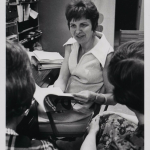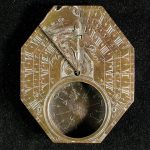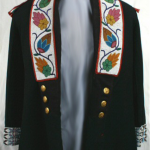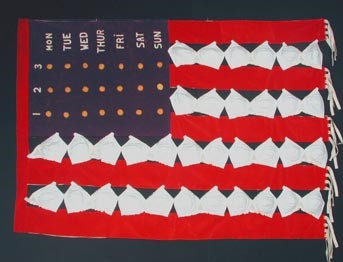
Marge Engelman’s The Land of the Freed-Up Woman embodies the progressive thinking of the Women’s Liberation Movement of the 1970s. Engelman’s decision to use two symbols of womanhood—birth control pills and bras—as the medium for her artwork transformed the recognizable flag into a message informing viewers of the importance of woman’s rights. The object was first displayed in the 1972 Neville Museum Art Show in Green Bay, WI and was later featured at a National Organization for Women (NOW) meeting.
In the blue field of the flag, Engelman fashioned faux birth control pills and letters out of white and gold felt, listing the days of the week. The felt pills allude to the recent FDA approval of the birth control pill and simultaneously convey the regulation of female bodies and women’s control over their own reproduction. Engelman crafted the red stripes from velveteen found around her home and the white stripes from several store-bought bras.[1]
The bras reference the “bra burning” of the 1970s, when women “freed-up” themselves by taking off their bras. Bra straps hang off the right side of the flag, functioning as a message of bra removal and as decorative fringe.
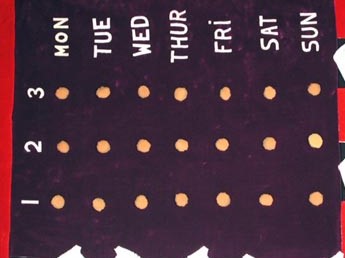
Engelman’s piece reflects her experience as a woman working in an administrative position during the 1970s. A resident of Green Bay, she worked at UW-Green Bay. In an interview, she accounts experiencing sexism in the workplace. A male coworker even admitted that he could only see Engelman as a sex object because she was a woman.[2]
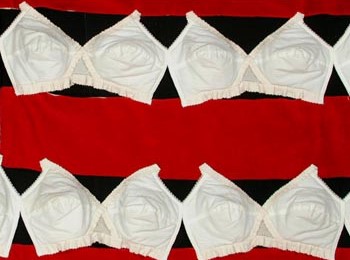
In 2002, a teacher at Madison Memorial High School used Engelman’s flag as inspiration; her students constructed a 21st century version of the flag, which moved Engelman to tears upon viewing.[3]
Written by Keeley Flynn, August 2021.
FOOTNOTES
[1] Marge Engelman, interview by Jane Rank (Oral History Interview, UW-Green Bay Oral History Collection, August 27, 2013).
[2] Ibid.
[3] Ibid.

